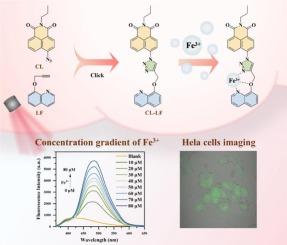Synthesis of naphthylimide-quinoline fluorescent probe for the detection of Fe3+ and its application to Hela cells imaging
IF 4.6
2区 化学
Q1 SPECTROSCOPY
Spectrochimica Acta Part A: Molecular and Biomolecular Spectroscopy
Pub Date : 2025-09-23
DOI:10.1016/j.saa.2025.126985
引用次数: 0
Abstract
In this work, a novel ratiometric fluorescent probe, CL-LF, specifically designed for the detection of iron ions (Fe3+), was synthesized through the Click reaction using naphthylimine and quinoline as fluorophores. The structure of CL-LF was characterized and analyzed using Fourier transform infrared absorption spectroscopy (FTIR), nuclear magnetic resonance (NMR), high-resolution mass spectrometry (HRMS) and Single-crystal XRD, and the detection mechanism of CL-LF was verified by density functional theory (DFT) calculations. In addition, the photophysical properties of CL-LF were analyzed by fluorescence emission spectroscopy. The results indicated that CL-LF exhibits significant sensitivity toward Fe3+, with a calculated limit of detection (LOD) of 0.18 μM and a rapid response time of 1 min. The addition of Fe3+ to the CL-LF system causes the fluorescence colour to change from weak blue to bright green under the irradiation of a 365 nm UV lamp. This change provided an intuitive basis for the visual detection of Fe3+. At the same time, CL-LF demonstrated excellent selectivity and anti-interference ability, effectively distinguishing Fe3+ from other interfering ions. Based on the favorable fluorescence properties of CL-LF, this study further explored its potential application in cells through cell imaging experiments. The experiments showed that CL-LF has low toxicity and good cytocompatibility with Hela cells. With its exceptional cell imaging capabilities, CL-LF holds promise as a novel tool for investigating Fe3+-related biological processes and diseases.

检测Fe3+的萘酰亚胺-喹啉荧光探针的合成及其在Hela细胞成像中的应用
本文以萘胺和喹啉为荧光团,通过Click反应合成了一种新型的比例荧光探针CL-LF,专门用于检测铁离子(Fe3+)。利用傅里叶变换红外吸收光谱(FTIR)、核磁共振(NMR)、高分辨率质谱(HRMS)和单晶XRD对CL-LF的结构进行了表征和分析,并通过密度泛函理论(DFT)计算验证了CL-LF的检测机理。此外,利用荧光发射光谱分析了CL-LF的光物理性质。结果表明,CL-LF对Fe3+具有显著的灵敏度,计算检测限(LOD)为0.18 μM,快速响应时间为1 min。在365 nm紫外灯的照射下,将Fe3+加入到CL-LF体系中,荧光颜色由弱蓝色变为亮绿色。这一变化为Fe3+的视觉检测提供了直观的依据。同时,CL-LF表现出优异的选择性和抗干扰能力,能有效区分Fe3+和其他干扰离子。基于CL-LF良好的荧光特性,本研究通过细胞成像实验进一步探索其在细胞中的应用潜力。实验表明,CL-LF具有低毒性和与Hela细胞良好的细胞相容性。CL-LF具有优异的细胞成像能力,有望成为研究Fe3+相关生物过程和疾病的新工具。
本文章由计算机程序翻译,如有差异,请以英文原文为准。
求助全文
约1分钟内获得全文
求助全文
来源期刊
CiteScore
8.40
自引率
11.40%
发文量
1364
审稿时长
40 days
期刊介绍:
Spectrochimica Acta, Part A: Molecular and Biomolecular Spectroscopy (SAA) is an interdisciplinary journal which spans from basic to applied aspects of optical spectroscopy in chemistry, medicine, biology, and materials science.
The journal publishes original scientific papers that feature high-quality spectroscopic data and analysis. From the broad range of optical spectroscopies, the emphasis is on electronic, vibrational or rotational spectra of molecules, rather than on spectroscopy based on magnetic moments.
Criteria for publication in SAA are novelty, uniqueness, and outstanding quality. Routine applications of spectroscopic techniques and computational methods are not appropriate.
Topics of particular interest of Spectrochimica Acta Part A include, but are not limited to:
Spectroscopy and dynamics of bioanalytical, biomedical, environmental, and atmospheric sciences,
Novel experimental techniques or instrumentation for molecular spectroscopy,
Novel theoretical and computational methods,
Novel applications in photochemistry and photobiology,
Novel interpretational approaches as well as advances in data analysis based on electronic or vibrational spectroscopy.

 求助内容:
求助内容: 应助结果提醒方式:
应助结果提醒方式:


